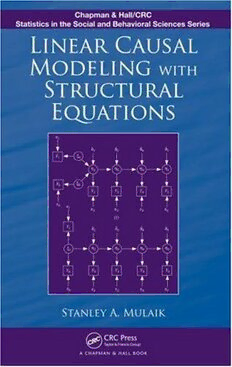Download Linear Causal Modeling with Structural Equations PDF Free - Full Version
Download Linear Causal Modeling with Structural Equations by Stanley A. Mulaik in PDF format completely FREE. No registration required, no payment needed. Get instant access to this valuable resource on PDFdrive.to!
About Linear Causal Modeling with Structural Equations
Emphasizing causation as a functional relationship between variables that describe objects, Linear Causal Modeling with Structural Equations integrates a general philosophical theory of causation with structural equation modeling (SEM) that concerns the special case of linear causal relations. In addition to describing how the functional relation concept may be generalized to treat probabilistic causation, the book reviews historical treatments of causation and explores recent developments in experimental psychology on studies of the perception of causation. It looks at how to perceive causal relations directly by perceiving quantities in magnitudes and motions of causes that are conserved in the effects of causal exchanges. The author surveys the basic concepts of graph theory useful in the formulation of structural models. Focusing on SEM, he shows how to write a set of structural equations corresponding to the path diagram, describes two ways of computing variances and covariances of variables in a structural equation model, and introduces matrix equations for the general structural equation model. The text then discusses the problem of identifying a model, parameter estimation, issues involved in designing structural equation models, the application of confirmatory factor analysis, equivalent models, the use of instrumental variables to resolve issues of causal direction and mediated causation, longitudinal modeling, and nonrecursive models with loops. It also evaluates models on several dimensions and examines the polychoric and polyserial correlation coefficients and their derivation. Covering the fundamentals of algebra and the history of causality, this book provides a solid understanding of causation, linear causal modeling, and SEM. It takes readers through the process of identifying, estimating, analyzing, and evaluating a range of models.
Detailed Information
| Author: | Stanley A. Mulaik |
|---|---|
| Publication Year: | 2009 |
| ISBN: | 9781439800386 |
| Pages: | 445 |
| Language: | English |
| File Size: | 5.669 |
| Format: | |
| Price: | FREE |
Safe & Secure Download - No registration required
Why Choose PDFdrive for Your Free Linear Causal Modeling with Structural Equations Download?
- 100% Free: No hidden fees or subscriptions required for one book every day.
- No Registration: Immediate access is available without creating accounts for one book every day.
- Safe and Secure: Clean downloads without malware or viruses
- Multiple Formats: PDF, MOBI, Mpub,... optimized for all devices
- Educational Resource: Supporting knowledge sharing and learning
Frequently Asked Questions
Is it really free to download Linear Causal Modeling with Structural Equations PDF?
Yes, on https://PDFdrive.to you can download Linear Causal Modeling with Structural Equations by Stanley A. Mulaik completely free. We don't require any payment, subscription, or registration to access this PDF file. For 3 books every day.
How can I read Linear Causal Modeling with Structural Equations on my mobile device?
After downloading Linear Causal Modeling with Structural Equations PDF, you can open it with any PDF reader app on your phone or tablet. We recommend using Adobe Acrobat Reader, Apple Books, or Google Play Books for the best reading experience.
Is this the full version of Linear Causal Modeling with Structural Equations?
Yes, this is the complete PDF version of Linear Causal Modeling with Structural Equations by Stanley A. Mulaik. You will be able to read the entire content as in the printed version without missing any pages.
Is it legal to download Linear Causal Modeling with Structural Equations PDF for free?
https://PDFdrive.to provides links to free educational resources available online. We do not store any files on our servers. Please be aware of copyright laws in your country before downloading.
The materials shared are intended for research, educational, and personal use in accordance with fair use principles.

